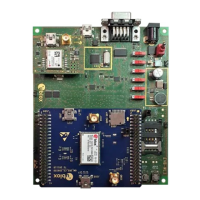SARA-R5 series - System integration manual
UBX-19041356 - R04 Design-in Page 52 of 118
C1-Public
2.2.1.11 Guidelines for grounding layout design
Good connection of the module GND pins with application PCB solid ground layer is required for correct
RF performance. It significantly reduces EMC issues and provides a thermal heat sink for the module.
• Connect each GND pin with application board solid GND layer. It is strongly recommended that
each GND pad surrounding VCC pins have one or more dedicated via down to the application board
solid ground layer.
• The VCC supply current flows back to main DC source through GND as ground current: provide
adequate return path with suitable uninterrupted ground plane to main DC source.
• It is recommended to implement one layer of the application PCB as GND plane as wide as possible.
• If the application board is a multilayer PCB, then all the layers should be filled with GND plane as
much as possible and each GND area should be connected together with complete via stack down
to the main ground layer of the board. Use as many vias as possible to connect the ground planes.
• Provide a dense line of vias at the edges of each GND area, in particular along RF and high speed
lines.
• If the whole application device is composed by more than one PCB, then it is required to provide a
good and solid ground connection between the GND areas of all the different PCBs.
• Good grounding of GND pads also ensures thermal heat sink. This is critical during connection,
when the real network commands the module to transmit at maximum power: correct grounding
helps prevent module overheating.
2.2.2 Generic digital interfaces supply output (V_INT)
2.2.2.1 Guidelines for V_INT circuit design
SARA-R5 series modules provide the V_INT generic digital interfaces 1.8 V supply output, which can
be mainly used to:
• Indicate when the module is switched on and it is not in the deep-sleep power saving mode
• Supply external devices, as voltage translators, instead of using an external discrete regulator
(e.g. see 2.6.1)
• Pull-up SIM detection signal (see section 2.5 for more details)
☞ Do not apply loads which might exceed the maximum available current from V_INT supply (see
SARA-R5 series data sheet [1]) as this can cause malfunctions in internal circuitry.
☞ V_INT can only be used as an output: do not connect any external supply source on V_INT.
☞ ESD sensitivity rating of the V_INT supply pin is 1 kV (HBM according to JESD22-A114). Higher
protection level could be required if the line is externally accessible and it can be achieved by
mounting an ESD protection (e.g. EPCOS CA05P4S14THSG) close to accessible point.
☞ It is recommended to monitor the V_INT pin to sense the end of the internal switch-off sequence
of SARA-R5 series modules: VCC supply can be removed only after V_INT goes low.
☞ It is recommended to provide direct access to the V_INT pin on the application board by means of
an accessible test point directly connected to the V_INT pin.
2.2.2.2 Guidelines for V_INT layout design
V_INT digital interfaces supply output is generated by an integrated switching step-down converter,
used internally to supply the digital interfaces. Because of this, it can be a source of noise: avoid
coupling with sensitive signals.

